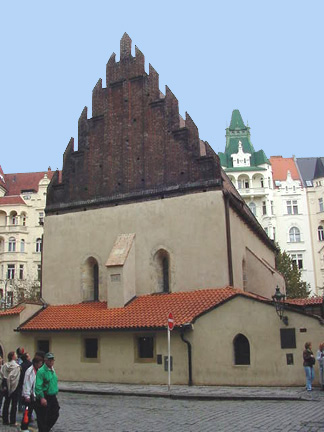The Jewish Museum in Prague
 Old-New Synagogue is
still in use as a house of prayer
Old-New Synagogue is
still in use as a house of prayer
The Jewish Museum in Prague consists
of exhibits in four of the old Synagogues and the Ceremonial
Hall, along with the Old Jewish Cemetery which extends from the
courtyard of the Pinkas Synagogue to the rear of the Ceremonial
Hall and the Klausen Synagogue.
There are two other Synagogues in the
old Jewish quarter that are still being used as places of worship,
so they have no exhibits. One of them is the Old-New Synagogue,
shown in the photograph above, which dates back to the 13th century;
it is open to the public as part of the museum, except on Saturdays
and Jewish Holidays. The other one is the High Synagogue which
is in the same building as the Old Town Hall; neither the town
hall nor the High Synagogue were on the museum tour when I visited
Prague in October, 2000. Some tourist guidebooks for Prague mention
the textile exhibits in the High Synagogue, which were not open
when I visited.
One ticket, which could be purchased
for 450 Kc in 2000 at any of the sights or at the Matana travel
agency at number 15 Maiselova street in Josefov, will allow a
person to enter five of the synagogues, the Ceremonial Hall and
the Old Jewish Cemetery. All the sights are open at 9:00 a.m.
daily except on Saturdays and Jewish Holidays. The printed ticket
looks like a credit card receipt and has an entry time for each
synagogue, a system that is designed to rush tourists through
the tour, allowing about 30 minutes at each sight. There were
so many interesting exhibits in the synagogues that I found it
impossible to adhere to my assigned entry times, but none of
the synagogues denied me admission because I was behind schedule.
Even though the Old-New Synagogue is still in use, tourists must
still pay to enter it, although when I was there, several people
claimed that they only wanted to go inside to pray.
The Jewish Museum in Prague has one of
the most extensive collections of Jewish art, textiles and silver
in the world; there are 40,000 exhibits and 100,000 books. The
collection is unique because everything in the museum was gathered
from Bohemia and Moravia and it represents Jewish history and
heritage in the present Czech Republic.
The Jewish Museum was founded in 1906
in order to preserve artifacts that were saved when all the buildings
in the old Jewish quarter were demolished at the turn of the
century, including some of the synagogues. Dr. Hugo Lieben and
Dr. Augustin Stein were the leaders in the founding of the museum.
Only six synagogues, the Ceremonial Hall, the Old Town Hall,
and the Old Jewish Cemetery were left standing when the old Jewish
quarter was torn down because it had become a rat-infested slum
that was a major health hazard.
The Nazis closed The Jewish Museum soon
after they occupied Bohemia and Moravia, the two states which
now make up the Czech Republic, on March 15, 1939. Prague is
located in Bohemia.
After the Nazis started liquidating the
Jewish communities in what is now the Czech Republic, Dr. Stein
proposed to the Germans that they set up a museum to hold all
the objects that the Nazis were confiscating from the synagogues
in Bohemia and Moravia. Following long negotiations between the
Nazis and the Jewish leaders, the Nazis approved the project
and in 1942, the Central Jewish Museum was created. Consequently,
memorial objects from the synagogues in the Czech Republic were
saved and they are now on display at four of the old synagogues:
the Pinkus Synagogue, the Klausen Synagogue, the Maisel Synagogue
and the Spanish Synagogue.
Although he didn't originate the idea
of the museum, Hitler became enthusiastic about the project.
Hitler blamed the Jews for Germany's defeat in World War I, and
on January 30, 1939, he had predicted that, in the event of another
world war, European Jewry would be annihilated. In 1942, he thought
the Germans would emerge victorious in World War II and that
all the Jews would be gone from Europe; he was planning to call
the Jewish Museum in Prague the "Exotic Museum of an Extinct
Race."
During World War II, Jewish artifacts
from all over Europe were brought to Prague and stored in preparation
for this museum. As it turned out, the artifacts that were saved
by the Nazis ended up in a museum in Prague, but thank God, it
is not a museum of an extinct race.
After the defeat of the Fascists in World
War II, Czechoslovakia became a Communist country in 1948. Under
Communism, all property is owned by the state, so in 1950 the
Jews were forced to transfer ownership of the Jewish Museum to
the state, and a number of restrictions were imposed. After the
collapse of the Communist regime in 1989, the Museum buildings
and their exhibits were returned to the Jews on October 1, 1994.
At this time, The Jewish Museum in Prague was founded as a non-state
organization.
In 1996, the Educational and Cultural
Center was established as part of the Museum complex. It is located
on the corner of Maiselova Street and Siroka Street in the heart
of Josefov. The purpose of the center is to give visitors a detailed
account of the history of the Jews, particularly the history
of the Jews in Bohemia and Moravia. The Center is a teacher training
institution recognized by the Czech Ministry of Education. The
program at the Center includes lectures, seminars, tours of Josefov,
movies, concerts, debates and literary evenings.
|